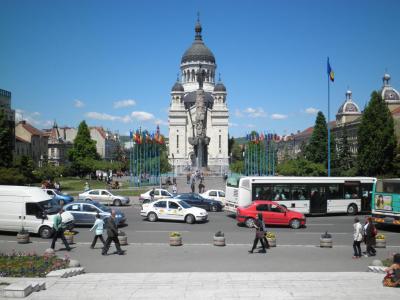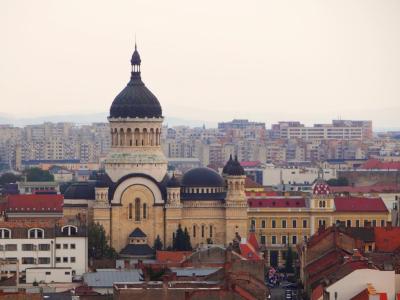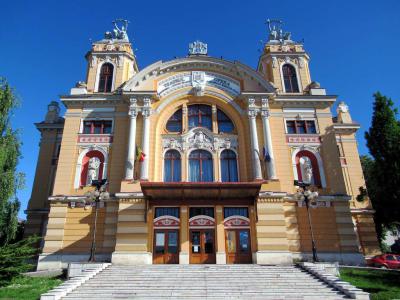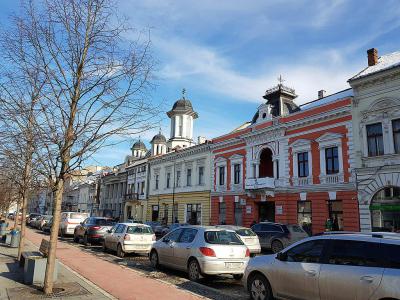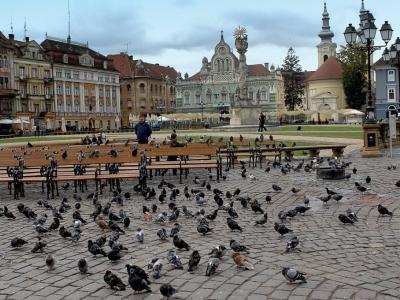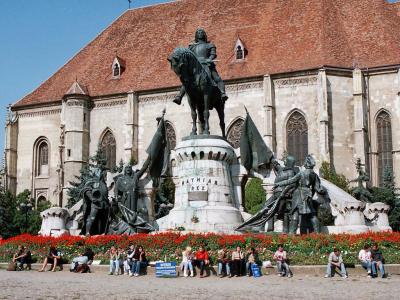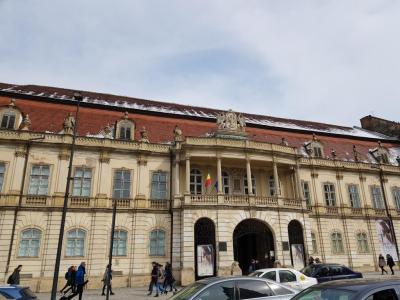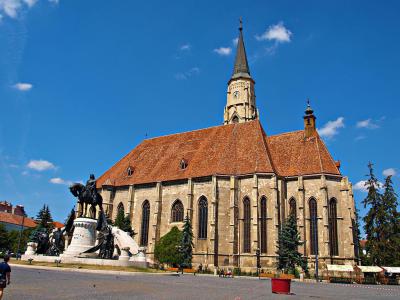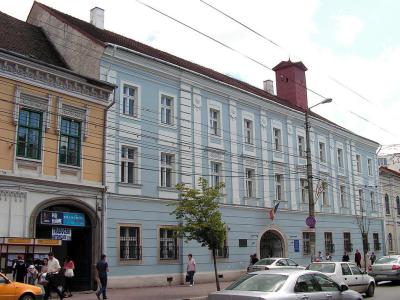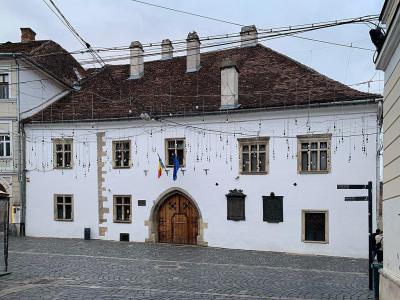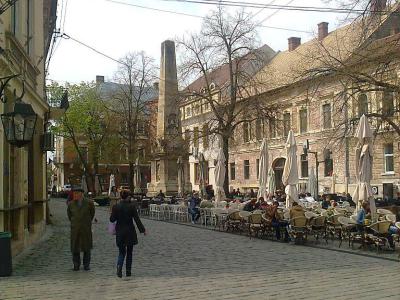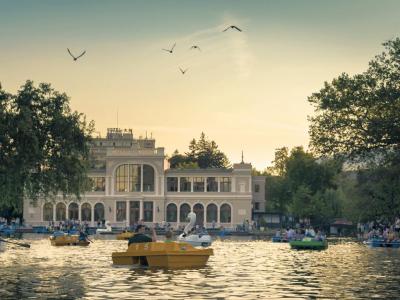Cluj-Napoca Introduction Walking Tour (Self Guided), Cluj-Napoca
The unofficial capital of Romania's Transylvania region, Cluj-Napoca (or just Cluj) is the city of universities, bustling nightlife, and historical sights, thanks to the legacy of Saxon and Hungarian rule. For its historical wealth, Cluj has been rightfully nicknamed a "treasure city".
Its official name has intriguing origins: "Cluj" is derived from the Latin "clausa" (which means “closed place”), whereas "Napoca" was the ancient settlement established by the Romans in the 100th AD. Its name possibly originated from the Greek word “napos” for timbered valley. In 1974, during Nicolae Ceaușescu's regime, the name Napoca was added to Cluj to highlight the city's historical roots, thus creating "Cluj-Napoca."
During the Middle Ages, Cluj developed into a wooden fortress and a civilian settlement within the Kingdom of Hungary. It was granted city status in 1316, gaining further importance under Habsburg rule in the late 17th century.
From 1830, Cluj became a center for the Hungarian national movement, playing a role in the Hungarian Revolution of 1848. After fluctuating control between Austrian and Hungarian forces, the city was briefly under Hungarian rule until Transylvania united with Romania in 1920. During World War II, Cluj was annexed by Hungary but was restored to Romania in 1944.
Post-war, despite ethnic tensions, the city saw industrial growth, followed by further economic development after the 1989 Romanian Revolution.
The old town of Cluj is centered around Union Square sided by a number of sites, including the impressive Gothic Saint Michael's Church, the monumental statue of the 15th-century king Matthias Corvinus, and the Baroque-style Banffy Palace, home to the National Museum of Art.
Avram Iancu Square, named after a prominent leader of the 1848 Transylvanian Revolution, serves as a bustling center of activity and a tribute to local heroes. Nearby, the Dormition of the Theotokos Cathedral stands as a striking example of Romanian Orthodox architecture, capturing both historical and spiritual significance.
For those interested in the performing arts, the National Theater offers a window into the cultural life of Cluj. Meanwhile, Heroes' Avenue, a lively boulevard, honoring the 1989 Revolution's heroes and martyrs, serves as the city's key recreational and commercial hub with historic landmarks and multiple dining options.
And if you seek a peaceful retreat from the city's hustle and bustle, Central Park is ideal for a leisurely stroll or a relaxing afternoon.
For a truly memorable Romanian adventure, dive into the history and beauty of Cluj-Napoca! Our self-guided tour of this lovely city is designed to deliver you an enjoyable experience.
Its official name has intriguing origins: "Cluj" is derived from the Latin "clausa" (which means “closed place”), whereas "Napoca" was the ancient settlement established by the Romans in the 100th AD. Its name possibly originated from the Greek word “napos” for timbered valley. In 1974, during Nicolae Ceaușescu's regime, the name Napoca was added to Cluj to highlight the city's historical roots, thus creating "Cluj-Napoca."
During the Middle Ages, Cluj developed into a wooden fortress and a civilian settlement within the Kingdom of Hungary. It was granted city status in 1316, gaining further importance under Habsburg rule in the late 17th century.
From 1830, Cluj became a center for the Hungarian national movement, playing a role in the Hungarian Revolution of 1848. After fluctuating control between Austrian and Hungarian forces, the city was briefly under Hungarian rule until Transylvania united with Romania in 1920. During World War II, Cluj was annexed by Hungary but was restored to Romania in 1944.
Post-war, despite ethnic tensions, the city saw industrial growth, followed by further economic development after the 1989 Romanian Revolution.
The old town of Cluj is centered around Union Square sided by a number of sites, including the impressive Gothic Saint Michael's Church, the monumental statue of the 15th-century king Matthias Corvinus, and the Baroque-style Banffy Palace, home to the National Museum of Art.
Avram Iancu Square, named after a prominent leader of the 1848 Transylvanian Revolution, serves as a bustling center of activity and a tribute to local heroes. Nearby, the Dormition of the Theotokos Cathedral stands as a striking example of Romanian Orthodox architecture, capturing both historical and spiritual significance.
For those interested in the performing arts, the National Theater offers a window into the cultural life of Cluj. Meanwhile, Heroes' Avenue, a lively boulevard, honoring the 1989 Revolution's heroes and martyrs, serves as the city's key recreational and commercial hub with historic landmarks and multiple dining options.
And if you seek a peaceful retreat from the city's hustle and bustle, Central Park is ideal for a leisurely stroll or a relaxing afternoon.
For a truly memorable Romanian adventure, dive into the history and beauty of Cluj-Napoca! Our self-guided tour of this lovely city is designed to deliver you an enjoyable experience.
How it works: Download the app "GPSmyCity: Walks in 1K+ Cities" from Apple App Store or Google Play Store to your mobile phone or tablet. The app turns your mobile device into a personal tour guide and its built-in GPS navigation functions guide you from one tour stop to next. The app works offline, so no data plan is needed when traveling abroad.
Cluj-Napoca Introduction Walking Tour Map
Guide Name: Cluj-Napoca Introduction Walking Tour
Guide Location: Romania » Cluj-Napoca (See other walking tours in Cluj-Napoca)
Guide Type: Self-guided Walking Tour (Sightseeing)
# of Attractions: 12
Tour Duration: 2 Hour(s)
Travel Distance: 2.1 Km or 1.3 Miles
Author: Dee
Sight(s) Featured in This Guide:
Guide Location: Romania » Cluj-Napoca (See other walking tours in Cluj-Napoca)
Guide Type: Self-guided Walking Tour (Sightseeing)
# of Attractions: 12
Tour Duration: 2 Hour(s)
Travel Distance: 2.1 Km or 1.3 Miles
Author: Dee
Sight(s) Featured in This Guide:
- Avram Iancu Square
- Dormition of the Theotokos Cathedral
- Teatrul National (National Theatre)
- Bulevardul Eroilor (Heroes' Avenue)
- Piața Unirii (Union Square)
- Matthias Corvinus Monument
- Banffy Palace and National Museum of Art
- St. Michael's Church
- Ethnographic Museum of Transylvania
- Matthias Corvinus House
- Piata Muzeului (Museum Square)
- Parcul Central (Central Park)
1) Avram Iancu Square
Avram Iancu Square is a significant and historic plaza located in the heart of Cluj-Napoca. Named after the renowned Transylvanian Romanian lawyer and revolutionary Avram Iancu, the square is a central hub that connects various key areas of the city, including the nearby Unirii Square through Eroilor and "21 Decembrie 1989" avenues, and Mihai Viteazul Square via Cuza Vodă Street. The square is steeped in history and architecture, reflecting the rich cultural heritage of Cluj-Napoca.
One of the most striking landmarks in Avram Iancu Square is the Dormition of the Theotokos Cathedral, a monumental Orthodox cathedral that dominates the plaza. This iconic structure, along with the eclectic Palace of Justice designed by Wagner Gyula, forms the architectural backbone of the square. Other important buildings surrounding the plaza include the Lucian Blaga National Theatre and the headquarters of the County Prefecture, each contributing to the square’s status as a central cultural and administrative center in Cluj-Napoca.
The square’s history is deeply intertwined with the old city walls, which were once guarded by three bastions and gates. Originally a marketplace, the area evolved significantly over time. As the marketplace was relocated closer to the railroad-now the site of Mihai Viteazul Square-the old city walls and gates were eventually demolished at the turn of the 20th century. In their place, a small park was created, and the square began to take on its current form with the construction of new buildings, including the National Theater, the Orthodox Cathedral, and several other significant structures in the Art Nouveau style.
Today, Avram Iancu Square stands as a testament to Cluj-Napoca’s historical and architectural evolution. The square is not only a place of great beauty but also a vital part of the city’s cultural fabric. It is home to numerous important institutions, including the Palace of Justice, the Faculty of Orthodox Theology, and the building of the Protestant Theology.
One of the most striking landmarks in Avram Iancu Square is the Dormition of the Theotokos Cathedral, a monumental Orthodox cathedral that dominates the plaza. This iconic structure, along with the eclectic Palace of Justice designed by Wagner Gyula, forms the architectural backbone of the square. Other important buildings surrounding the plaza include the Lucian Blaga National Theatre and the headquarters of the County Prefecture, each contributing to the square’s status as a central cultural and administrative center in Cluj-Napoca.
The square’s history is deeply intertwined with the old city walls, which were once guarded by three bastions and gates. Originally a marketplace, the area evolved significantly over time. As the marketplace was relocated closer to the railroad-now the site of Mihai Viteazul Square-the old city walls and gates were eventually demolished at the turn of the 20th century. In their place, a small park was created, and the square began to take on its current form with the construction of new buildings, including the National Theater, the Orthodox Cathedral, and several other significant structures in the Art Nouveau style.
Today, Avram Iancu Square stands as a testament to Cluj-Napoca’s historical and architectural evolution. The square is not only a place of great beauty but also a vital part of the city’s cultural fabric. It is home to numerous important institutions, including the Palace of Justice, the Faculty of Orthodox Theology, and the building of the Protestant Theology.
2) Dormition of the Theotokos Cathedral (must see)
The Dormition of the Theotokos Cathedral is a prominent Romanian Orthodox church. Known for its stunning Romanian Brâncovenesc architectural style, the cathedral is a beautiful synthesis of Renaissance and Byzantine elements. It stands as a significant landmark in Avram Iancu Square, sharing the space with other important structures like the Cluj-Napoca National Theatre and the Avram Iancu Statue.
The cathedral is the seat of the Metropolitan of Cluj, Alba, Crișana, and Maramureș, making it a central figure in the religious life of the region. It is dedicated to the Dormition of the Theotokos, a significant event in Orthodox Christianity commemorating the "falling asleep" or death of the Virgin Mary. The construction of this majestic building began on 10 September 1923, shortly after the Union of Transylvania with the Romanian Old Kingdom, and was completed a decade later, in 1933.
Nicolae Ivan, who served as the Bishop of Cluj during this period, played a crucial role in the establishment of the cathedral. His efforts were instrumental in choosing the location and securing the necessary funds for its construction. The cathedral not only serves as a place of worship but also stands as a symbol of the unity and cultural identity of the Romanian people in Transylvania.
The cathedral is the seat of the Metropolitan of Cluj, Alba, Crișana, and Maramureș, making it a central figure in the religious life of the region. It is dedicated to the Dormition of the Theotokos, a significant event in Orthodox Christianity commemorating the "falling asleep" or death of the Virgin Mary. The construction of this majestic building began on 10 September 1923, shortly after the Union of Transylvania with the Romanian Old Kingdom, and was completed a decade later, in 1933.
Nicolae Ivan, who served as the Bishop of Cluj during this period, played a crucial role in the establishment of the cathedral. His efforts were instrumental in choosing the location and securing the necessary funds for its construction. The cathedral not only serves as a place of worship but also stands as a symbol of the unity and cultural identity of the Romanian people in Transylvania.
3) Teatrul National (National Theatre)
The Lucian Blaga National Theatre is a cornerstone of Romanian cultural life, renowned as one of the most prestigious theatrical institutions in the country. Sharing its impressive building with the Romanian Opera, the theatre has been a hub of artistic expression and performance since its establishment in the early 20th century. Built between 1904 and 1906, the theatre was the brainchild of the celebrated Austrian architects Ferdinand Fellner and Hermann Helmer, who were known for designing numerous theatres and palaces across Europe during that period. The building's construction was entirely financed through private funds, reflecting the strong cultural and civic commitment of the local community.
The theatre's design is a splendid example of Neo-Baroque architecture, featuring a grand hall that originally accommodated 928 seats. The architectural style is characterized by ornate details, with some influences of Secessionism visible in the decoration of the foyer. This blend of styles gives the building a distinctive and elegant appearance, making it a significant architectural landmark in Cluj-Napoca.
Over the years, the theatre has undergone several renovations and expansions to meet the growing demands of its audience. Between 1950 and 1956, the stage house was extended, increasing the seating capacity to 1,200. This expansion allowed the theatre to host larger productions and accommodate more visitors, further solidifying its status as a leading cultural institution.
The Lucian Blaga National Theatre continues to play a vital role in Romania's artistic scene, offering a diverse range of performances that attract both local residents and visitors from around the world. Its rich history, architectural beauty, and ongoing contributions to the arts make it a true gem in the heart of Cluj-Napoca.
The theatre's design is a splendid example of Neo-Baroque architecture, featuring a grand hall that originally accommodated 928 seats. The architectural style is characterized by ornate details, with some influences of Secessionism visible in the decoration of the foyer. This blend of styles gives the building a distinctive and elegant appearance, making it a significant architectural landmark in Cluj-Napoca.
Over the years, the theatre has undergone several renovations and expansions to meet the growing demands of its audience. Between 1950 and 1956, the stage house was extended, increasing the seating capacity to 1,200. This expansion allowed the theatre to host larger productions and accommodate more visitors, further solidifying its status as a leading cultural institution.
The Lucian Blaga National Theatre continues to play a vital role in Romania's artistic scene, offering a diverse range of performances that attract both local residents and visitors from around the world. Its rich history, architectural beauty, and ongoing contributions to the arts make it a true gem in the heart of Cluj-Napoca.
4) Bulevardul Eroilor (Heroes' Avenue) (must see)
Heroes' Avenue holds a special place in the hearts of locals and visitors alike. It serves as a vital conduit between squares, doubling as a recreational space for residents to unwind with friends or enjoy a leisurely stroll.
Originally known as Middle Street, the boulevard underwent several name changes over the years. At the close of the nineteenth century, it was dedicated to Ferenc Deák, a revered Hungarian politician known as "the wise man of the fatherland." Subsequently, it was named after Queen Maria, and later, in the 1950s, it bore the name of the Soviet Foreign Minister, Vyacheslav Molotov, following the Second World War. During the era of Romanian Prime Minister Dr. Petru Groza, the boulevard carried his name. However, in 1990, it was renamed in honor of the heroes and martyrs of the revolution who bravely assembled on December 21, 1989, demanding the overthrow of the communist regime.
Heroes' Avenue thrives as a bustling commercial artery, complemented by an array of dining and entertainment establishments. Its historic landmarks, such as the Lupa Carolina Statue near the Greek-Catholic Cathedral "Transfiguration" and the Monument of the Memorandists at the entrance from Unirii Square, offer glimpses into Cluj's rich heritage.
Originally known as Middle Street, the boulevard underwent several name changes over the years. At the close of the nineteenth century, it was dedicated to Ferenc Deák, a revered Hungarian politician known as "the wise man of the fatherland." Subsequently, it was named after Queen Maria, and later, in the 1950s, it bore the name of the Soviet Foreign Minister, Vyacheslav Molotov, following the Second World War. During the era of Romanian Prime Minister Dr. Petru Groza, the boulevard carried his name. However, in 1990, it was renamed in honor of the heroes and martyrs of the revolution who bravely assembled on December 21, 1989, demanding the overthrow of the communist regime.
Heroes' Avenue thrives as a bustling commercial artery, complemented by an array of dining and entertainment establishments. Its historic landmarks, such as the Lupa Carolina Statue near the Greek-Catholic Cathedral "Transfiguration" and the Monument of the Memorandists at the entrance from Unirii Square, offer glimpses into Cluj's rich heritage.
5) Piața Unirii (Union Square)
Union Square stands as the vibrant heart of Cluj-Napoca, serving as both a cultural and social epicenter for the city. This expansive square, one of the largest in Romania, measures an impressive 220 meters by 160 meters and has been a central hub for the community for centuries. The square’s strategic location makes it an ideal starting point for anyone wishing to explore the city’s rich history and architectural grandeur. Union Square is not only a bustling meeting point but also a showcase of Cluj-Napoca’s finest buildings, cafes, and restaurants, making it a lively and essential part of the city's identity.
Dominating Union Square is the stunning Saint Michael's Church, a masterpiece of Gothic architecture that boasts the tallest church tower in Romania, reaching 80 meters. The church’s construction spanned from 1316 to 1487, in two distinct phases, reflecting the evolving architectural styles of the time. Adjacent to the church is the statue of Matthias Corvinus, a revered King of Hungary, adding a historical and regal presence to the square. These landmarks not only enhance the square's aesthetic appeal but also serve as reminders of Cluj-Napoca’s deep-rooted history and its significance in the region.
Surrounding the square are several other notable buildings that contribute to the area’s rich architectural tapestry. The old town hall, now an iconic structure, stands alongside the National Museum of Art, offering visitors a glimpse into the city’s artistic and political heritage. The Josika Palace and the Rhédey Palace further add to the square’s allure, each with its own unique architectural style and historical significance. These buildings, together with the square itself, form a central district that is both historically significant and visually captivating.
Originally known as Nagypiac in Hungarian, meaning "Big Market Square," Union Square was once the bustling marketplace of Cluj-Napoca. Its name and purpose have evolved over time, but its importance as the city's central square has remained constant. Today, Union Square continues to be a place where history, culture, and daily life intersect, making it a must-visit destination for anyone exploring Cluj-Napoca.
Dominating Union Square is the stunning Saint Michael's Church, a masterpiece of Gothic architecture that boasts the tallest church tower in Romania, reaching 80 meters. The church’s construction spanned from 1316 to 1487, in two distinct phases, reflecting the evolving architectural styles of the time. Adjacent to the church is the statue of Matthias Corvinus, a revered King of Hungary, adding a historical and regal presence to the square. These landmarks not only enhance the square's aesthetic appeal but also serve as reminders of Cluj-Napoca’s deep-rooted history and its significance in the region.
Surrounding the square are several other notable buildings that contribute to the area’s rich architectural tapestry. The old town hall, now an iconic structure, stands alongside the National Museum of Art, offering visitors a glimpse into the city’s artistic and political heritage. The Josika Palace and the Rhédey Palace further add to the square’s allure, each with its own unique architectural style and historical significance. These buildings, together with the square itself, form a central district that is both historically significant and visually captivating.
Originally known as Nagypiac in Hungarian, meaning "Big Market Square," Union Square was once the bustling marketplace of Cluj-Napoca. Its name and purpose have evolved over time, but its importance as the city's central square has remained constant. Today, Union Square continues to be a place where history, culture, and daily life intersect, making it a must-visit destination for anyone exploring Cluj-Napoca.
6) Matthias Corvinus Monument (must see)
The Matthias Corvinus Monument, located in Union Square, is one of the city's most iconic landmarks. The monument features a grand equestrian statue of Matthias Corvinus, a revered historical figure who was born in Cluj-Napoca in 1443 and later became the King of Hungary and Croatia. His reign from 1458 to 1490 was marked by significant achievements, including the centralization of state power, which helped to fortify his kingdom against the Ottoman Empire. To support his military campaigns, Matthias Corvinus increased taxes and expanded his territories, ultimately creating the first permanent professional army in Europe, known as the Black Army.
The monument, crafted by the renowned sculptor János Fadrusz, was unveiled to the public on October 12, 1902, amidst grand festivities. The bronze statues, including the main figure of Matthias Corvinus and four of his most trusted generals, were transported to Cluj-Napoca by train and then carefully moved to Union Square on the tracks of an old horse tram line. The monument’s placement in the heart of the city emphasizes its significance in Cluj-Napoca’s cultural and historical landscape.
One of the unique features of the equestrian statue is that all four of the horse’s hooves are firmly on the ground. This detail is traditionally interpreted to signify that Matthias Corvinus, depicted on the horse, died a natural death rather than in battle. Surrounding the statue of Matthias Corvinus are his four generals, each holding flags representing the military battalions they led to victory. These generals include Blasius Magyar, the leader of the Black Army; Pál Kinizsi, Count of Timiș; Stephen Zápolya, Palatine of Hungary; and Stephen Báthory, Prince of Transylvania.
The Matthias Corvinus Monument not only serves as a tribute to one of Cluj-Napoca's most illustrious sons but also as a symbol of the city's rich historical legacy.
The monument, crafted by the renowned sculptor János Fadrusz, was unveiled to the public on October 12, 1902, amidst grand festivities. The bronze statues, including the main figure of Matthias Corvinus and four of his most trusted generals, were transported to Cluj-Napoca by train and then carefully moved to Union Square on the tracks of an old horse tram line. The monument’s placement in the heart of the city emphasizes its significance in Cluj-Napoca’s cultural and historical landscape.
One of the unique features of the equestrian statue is that all four of the horse’s hooves are firmly on the ground. This detail is traditionally interpreted to signify that Matthias Corvinus, depicted on the horse, died a natural death rather than in battle. Surrounding the statue of Matthias Corvinus are his four generals, each holding flags representing the military battalions they led to victory. These generals include Blasius Magyar, the leader of the Black Army; Pál Kinizsi, Count of Timiș; Stephen Zápolya, Palatine of Hungary; and Stephen Báthory, Prince of Transylvania.
The Matthias Corvinus Monument not only serves as a tribute to one of Cluj-Napoca's most illustrious sons but also as a symbol of the city's rich historical legacy.
7) Banffy Palace and National Museum of Art
Bánffy Palace, an exquisite example of 18th-century Baroque architecture, is one of Cluj-Napoca's most significant historical buildings. Designed by the German architect Johann Eberhard Blaumann and constructed between 1774 and 1775, the palace stands as a testament to the opulence and grandeur of the period. The palace was initially commissioned by György Bánffy, a Hungarian duke and the governor of Transylvania, who sought to create a residence that reflected his stature and influence. The result was a stunning architectural masterpiece that continues to be regarded as the most representative Baroque building in Transylvania.
The structure of Bánffy Palace is impressive in both scale and design. The building covers a floor area of 66 by 48 meters, with an inner courtyard measuring 26 by 26 meters. The palace is arranged with wings on either side, each containing a row of rooms, while the front and back wings include two rows. The inner courtyard, surrounded by a portico on the second floor, adds to the palace's majestic atmosphere. The façade is richly adorned with statues of classical figures, including Mars, Minerva, Apollo, Diana, Hercules, and Perseus, as well as the Bánffy family coat of arms, flanked by gryphons. A prominent feature of the palace is its central gate, which is topped by a loggia with seven pillars, adding to the building's regal appearance.
In February 1951, the city council decided to repurpose Bánffy Palace, transforming it into an art museum. After extensive renovations, the museum was officially opened on December 30, 1965. The conversion of the palace into a cultural institution marked a new chapter in its history, allowing the public to appreciate both its architectural beauty and the rich collection of art housed within its walls. The cinema that once occupied the inner courtyard was demolished in 1974, further restoring the palace's original grandeur.
Since 1951, the Banffy Palace has been the home of the National Museum of Art in Cluj-Napoca. This is a picture, graphic and decorative art patrimony. The permanent exhibits present works of such artists as Theodor Pallady, Camil Ressu, Vasile Popescu, and others. The National Museum of Art was awarded the European Museum of the Year award by the EMYA in 1997.
The structure of Bánffy Palace is impressive in both scale and design. The building covers a floor area of 66 by 48 meters, with an inner courtyard measuring 26 by 26 meters. The palace is arranged with wings on either side, each containing a row of rooms, while the front and back wings include two rows. The inner courtyard, surrounded by a portico on the second floor, adds to the palace's majestic atmosphere. The façade is richly adorned with statues of classical figures, including Mars, Minerva, Apollo, Diana, Hercules, and Perseus, as well as the Bánffy family coat of arms, flanked by gryphons. A prominent feature of the palace is its central gate, which is topped by a loggia with seven pillars, adding to the building's regal appearance.
In February 1951, the city council decided to repurpose Bánffy Palace, transforming it into an art museum. After extensive renovations, the museum was officially opened on December 30, 1965. The conversion of the palace into a cultural institution marked a new chapter in its history, allowing the public to appreciate both its architectural beauty and the rich collection of art housed within its walls. The cinema that once occupied the inner courtyard was demolished in 1974, further restoring the palace's original grandeur.
Since 1951, the Banffy Palace has been the home of the National Museum of Art in Cluj-Napoca. This is a picture, graphic and decorative art patrimony. The permanent exhibits present works of such artists as Theodor Pallady, Camil Ressu, Vasile Popescu, and others. The National Museum of Art was awarded the European Museum of the Year award by the EMYA in 1997.
8) St. Michael's Church (must see)
Saint Michael's Church is one of the most iconic landmarks in Transylvania, renowned for its Gothic architecture and historical significance. As the second-largest church in the region, it is an impressive structure, with a nave that stretches 50 meters long and 24 meters wide, and an apse measuring 20 by 10 meters. The church's most striking feature is its 76-meter-high tower, which holds the distinction of being the tallest in Transylvania. This towering spire, visible from many parts of the city, is a testament to the church's architectural grandeur and its prominence in the skyline of Cluj-Napoca.
The origins of Saint Michael's Church date back to 1316 when construction began, likely on the site of the former Saint James Chapel. The oldest part of the church, the altar, was inaugurated in 1390, and the main structure was completed by 1447. However, the church has undergone several changes over the centuries, including the construction of its original tower between 1511 and 1545. The current tower, built in the Gothic Revival style, was erected in 1862, replacing the older structure and adding to the church's majestic appearance.
Throughout its history, Saint Michael's Church has served various Christian denominations, including Roman Catholics, Lutheran Protestants, Calvinists, and Unitarians. This diverse religious heritage highlights the church's central role in the spiritual life of the city and its adaptability to the changing religious landscape of Transylvania. The western portal of the church is adorned with the coats of arms of Sigismund, reflecting his roles as King of Hungary, King of the Czech Kingdom, and Holy Roman Emperor, further emphasizing the church's historical significance.
Saint Michael's Church has also been the site of many important historical events, making it not just a place of worship but also a symbol of the city's rich history. Its towering presence and storied past continue to attract visitors and worshippers alike, offering a glimpse into the architectural and cultural heritage of Cluj-Napoca.
The origins of Saint Michael's Church date back to 1316 when construction began, likely on the site of the former Saint James Chapel. The oldest part of the church, the altar, was inaugurated in 1390, and the main structure was completed by 1447. However, the church has undergone several changes over the centuries, including the construction of its original tower between 1511 and 1545. The current tower, built in the Gothic Revival style, was erected in 1862, replacing the older structure and adding to the church's majestic appearance.
Throughout its history, Saint Michael's Church has served various Christian denominations, including Roman Catholics, Lutheran Protestants, Calvinists, and Unitarians. This diverse religious heritage highlights the church's central role in the spiritual life of the city and its adaptability to the changing religious landscape of Transylvania. The western portal of the church is adorned with the coats of arms of Sigismund, reflecting his roles as King of Hungary, King of the Czech Kingdom, and Holy Roman Emperor, further emphasizing the church's historical significance.
Saint Michael's Church has also been the site of many important historical events, making it not just a place of worship but also a symbol of the city's rich history. Its towering presence and storied past continue to attract visitors and worshippers alike, offering a glimpse into the architectural and cultural heritage of Cluj-Napoca.
9) Ethnographic Museum of Transylvania
The Ethnographic Museum of Transylvania is a cultural gem that offers a deep dive into the rural traditions and lifestyle of the Transylvanian region. Established over 80 years ago, it is one of the oldest and most significant ethnographic museums in Romania. The museum is divided into two main exhibition sections: one housed in the historic Reduta Palace in downtown Cluj-Napoca, and the other in the open-air Romulus Vuia Park, situated in the Hoia Forest on the city's north-western side. This dual setup allows visitors to experience both the indoor collections and the immersive outdoor exhibits that bring the region's rural heritage to life.
The museum's vast collection includes more than 50,000 objects that showcase the daily lives, occupations, and traditions of Transylvania's rural population. The Reduta Palace section presents a carefully curated selection of these artifacts, offering insight into the tools, clothing, and household items that were integral to village life. The open-air section in Romulus Vuia Park, on the other hand, provides a more hands-on experience, with traditional houses, barns, and other structures reconstructed to reflect the authentic rural environment. This combination of indoor and outdoor exhibits makes the museum a comprehensive resource for understanding the cultural history of Transylvania.
In addition to its extensive collection of artifacts, the Ethnographic Museum of Transylvania also boasts a rich archive of visual documentation. The museum's collection includes around 50,000 photographs and 5,000 diapositives, providing a visual record of the region's history and traditions. These images, along with the museum's library of approximately 12,000 scholarly journals and specialized magazines, serve as valuable resources for researchers and enthusiasts alike. The library's extensive holdings underscore the museum's role as a center for the study and preservation of Transylvanian ethnography.
The museum's vast collection includes more than 50,000 objects that showcase the daily lives, occupations, and traditions of Transylvania's rural population. The Reduta Palace section presents a carefully curated selection of these artifacts, offering insight into the tools, clothing, and household items that were integral to village life. The open-air section in Romulus Vuia Park, on the other hand, provides a more hands-on experience, with traditional houses, barns, and other structures reconstructed to reflect the authentic rural environment. This combination of indoor and outdoor exhibits makes the museum a comprehensive resource for understanding the cultural history of Transylvania.
In addition to its extensive collection of artifacts, the Ethnographic Museum of Transylvania also boasts a rich archive of visual documentation. The museum's collection includes around 50,000 photographs and 5,000 diapositives, providing a visual record of the region's history and traditions. These images, along with the museum's library of approximately 12,000 scholarly journals and specialized magazines, serve as valuable resources for researchers and enthusiasts alike. The library's extensive holdings underscore the museum's role as a center for the study and preservation of Transylvanian ethnography.
10) Matthias Corvinus House
The Matthias Corvinus House is one of Cluj-Napoca's most historically significant buildings, dating back to the 15th century. Originally constructed as a small guesthouse, this Gothic structure has played various roles throughout its long history, serving as a jail, hospital, and museum. Today, it houses a visual arts institute, continuing its tradition of being a place of importance in the city's cultural life.
This building is particularly renowned as the birthplace of Matthias Corvinus, the son of John Hunyadi, a legendary Transylvanian warrior. Matthias Corvinus, the Voivode of Transylvania, who would later rise to become one of Hungary's most celebrated kings, was born in this building on February 23, 1443. At that time, the house belonged to Jakab (James) Méhffi, a prosperous wine-grower and merchant in the city. On September 28, 1467, King Matthias granted a tax and duty exemption privilege to all descendants of the Méhffi family, who owned the building.
Over the centuries, the Matthias Corvinus House has undergone several transformations, reflecting the evolving architectural styles and needs of the times. It has been a college and has housed ethnographic collections of the Transylvanian Carpathian Society. Despite these changes, the building retains its Gothic roots, serving as a physical reminder of the city's rich past and its connection to significant historical figures.
This building is particularly renowned as the birthplace of Matthias Corvinus, the son of John Hunyadi, a legendary Transylvanian warrior. Matthias Corvinus, the Voivode of Transylvania, who would later rise to become one of Hungary's most celebrated kings, was born in this building on February 23, 1443. At that time, the house belonged to Jakab (James) Méhffi, a prosperous wine-grower and merchant in the city. On September 28, 1467, King Matthias granted a tax and duty exemption privilege to all descendants of the Méhffi family, who owned the building.
Over the centuries, the Matthias Corvinus House has undergone several transformations, reflecting the evolving architectural styles and needs of the times. It has been a college and has housed ethnographic collections of the Transylvanian Carpathian Society. Despite these changes, the building retains its Gothic roots, serving as a physical reminder of the city's rich past and its connection to significant historical figures.
11) Piata Muzeului (Museum Square)
The Museum Square is a captivating historical and cultural hub in the heart of Cluj-Napoca. This charming square is flanked by notable architectural and historic landmarks, creating a rich tapestry of the city’s heritage. Central to the square is the National Museum of Transylvanian History, which houses an extensive collection of antiquities, zoological specimens, and mineralogical artifacts. The museum provides an in-depth look into the region's past, showcasing the rich and varied history of Transylvania.
Adjacent to the museum stands the Franciscan Church, a significant religious and architectural site that adds to the square’s historic ambiance. Not far from the church, visitors will find the Carolina Obelisk, a striking monument that commemorates the visit of Archduchess Carolina to Cluj-Napoca. The obelisk, with its elegant design, contributes to the square's historical narrative and provides a focal point for both locals and tourists.
Museum Square also offers a delightful array of quaint restaurants and terraces. These establishments provide the perfect setting to relax and enjoy the vibrant atmosphere of the square while savoring local and international cuisine. The combination of historic sites and lively dining options makes Museum Square an atractive destination for anyone exploring the cultural and architectural richness of Cluj-Napoca.
Adjacent to the museum stands the Franciscan Church, a significant religious and architectural site that adds to the square’s historic ambiance. Not far from the church, visitors will find the Carolina Obelisk, a striking monument that commemorates the visit of Archduchess Carolina to Cluj-Napoca. The obelisk, with its elegant design, contributes to the square's historical narrative and provides a focal point for both locals and tourists.
Museum Square also offers a delightful array of quaint restaurants and terraces. These establishments provide the perfect setting to relax and enjoy the vibrant atmosphere of the square while savoring local and international cuisine. The combination of historic sites and lively dining options makes Museum Square an atractive destination for anyone exploring the cultural and architectural richness of Cluj-Napoca.
12) Parcul Central (Central Park) (must see)
Central Park is a verdant oasis in the heart of Cluj-Napoca, blending historical significance with natural beauty. Established in the 19th century, this park is one of the city's oldest and most picturesque green spaces, offering a serene escape from the bustling urban environment. Located on the southern shore of the Someșul Mic River, the park provides a scenic backdrop for both leisurely strolls and various recreational activities.
One of the park's highlights is its statuary group, which features an extraordinary fountain that serves as a focal point for visitors. The park's expansive lake adds to its charm, providing opportunities for boating and offering a tranquil setting for relaxation. The surrounding landscape, with its well-maintained lawns and shaded pathways, makes Central Park an ideal spot for both locals and tourists to unwind.
In addition to its natural beauty, Central Park is also a hub for education and culture. It is home to the University of Arts and Design and the Chemistry Faculty of Babeș-Bolyai University, adding an academic atmosphere to the park's serene environment. The park also holds a special place in the history of sports in Cluj-Napoca, as it was the site of the first Cluj derby between CFR and Universitatea in 1920.
Central Park has undergone significant restoration efforts, most notably in 2012, when the Old Casino building was meticulously renovated. This historical structure now stands as a testament to the park's enduring legacy. Each year, the west half of the park transforms into a vibrant festival ground during the Untold Festival, highlighting its role as a dynamic and multifunctional space in the heart of Cluj-Napoca.
One of the park's highlights is its statuary group, which features an extraordinary fountain that serves as a focal point for visitors. The park's expansive lake adds to its charm, providing opportunities for boating and offering a tranquil setting for relaxation. The surrounding landscape, with its well-maintained lawns and shaded pathways, makes Central Park an ideal spot for both locals and tourists to unwind.
In addition to its natural beauty, Central Park is also a hub for education and culture. It is home to the University of Arts and Design and the Chemistry Faculty of Babeș-Bolyai University, adding an academic atmosphere to the park's serene environment. The park also holds a special place in the history of sports in Cluj-Napoca, as it was the site of the first Cluj derby between CFR and Universitatea in 1920.
Central Park has undergone significant restoration efforts, most notably in 2012, when the Old Casino building was meticulously renovated. This historical structure now stands as a testament to the park's enduring legacy. Each year, the west half of the park transforms into a vibrant festival ground during the Untold Festival, highlighting its role as a dynamic and multifunctional space in the heart of Cluj-Napoca.
The Most Popular Cities
/ view all



